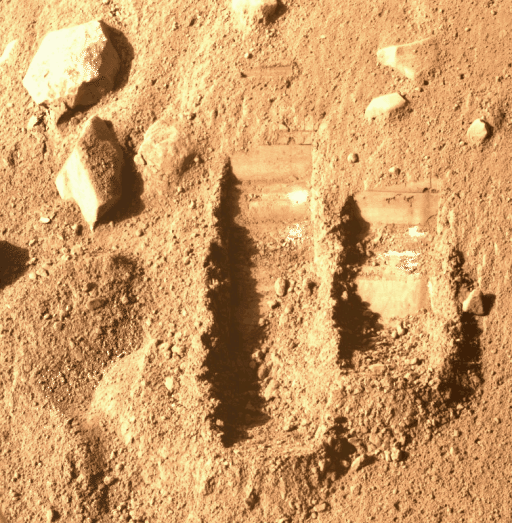Emily Lakdawalla • Jun 10, 2008
Phoenix Sol 14 summary: Attempt to shake sample into TEGA fails, sample for optical microscope gathered
Emily is on vacation until June 16. In the meantime, James Canvin is providing updates on the status of Phoenix. James used to work as an extragalactic astronomer, but recently switched fields to terrestrial weather. In his spare time he works in between these two fields, following and processing data from planetary spacecraft, in particular the near-real-time raw data from the Mars Exploration Rovers and Phoenix.

After several weeks of amazing work covering the Phoenix landing, Emily is taking a well earned vacation. For Phoenix and the scientists and engineers operating her, no break is possible. I'll be filling in to provide the highlights of another busy week in the Martian arctic.
Following the problem of getting a sample into the TEGA instrument on sol 12, the planned activity with this instrument for sol 13 -- which would have included closing the oven and starting the analysis -- was postponed while the team worked on understanding the issue. Phoenix stayed busy by expanding the first trench, known as Dodo, and performing some color and stereo imaging with the mast mounted camera.
On sol 14, an attempt was made to shake the problematic TEGA screen to try to get some soil particles into the instrument. Unfortunately this was not successful -- some motion was seen in the pile on top, but only a few particles were detected entering the oven. Phoenix also used its arm to collect another sample from the Baby Bear site that will eventually be delivered to the optical microscope.

NASA/JPL/UA animation by James Canvin
Digging at the Dodo and Baby Bear on Sols 13 and 14
This animation (click to enlarge to see the animation) compares color images of the trenches between sols 12 and 14. Dodo, the test trench on the left had a third scoopful removed on sol 13; the dump from this can be seen on the far left. Baby Bear, the trench on the right, had a second scoopful taken on sol 14 which is destined to be the first sample delivered to the optical microscope. Note that more bright material had been uncovered in both trenches.
NASA/JPL/UA/MPI animation by Gordan Ugarkovic
An Avalanche on TEGA
One of the main tasks for sol 14 was to shake the TEGA instrument to help some material pass through the outer mesh using a built-in mechanical shaker designed for this task. In this animation you can see movement of some material dumped onto the instrument that was caused by this activity. To orient you, this image taken using the robotic arm camera is looking approximately vertically down onto TEGA. The doors of TEGA are angled at around 45 degrees to the horizontal with the part visible at the bottom of this image the highest point, sloping down toward the top-left. The motion seen here is from the soil slumping down the slope. This motion proves that the shaker is working. Unfortunately however, very little soil passed through the mesh underneath.The plan for sol 15 includes three more attempts at different times of day to shake the mesh on TEGA, the team however is not very confident this will work, and the longer term plan is to try sprinkling the soil gently onto a fresh oven (there are a total of eight on Phoenix). This sprinkling method will also be used to get the sample currently in the scoop to the optical microscope. The sample will first be sprinkled over the site where previous soil has been dumped to remove the large clods, followed by a test sprinkle over the microscope to prove that a small sample can be delivered. If this all goes to plan, then a sample will be sprinkled into the microscope for real on sol 16.


 Explore Worlds
Explore Worlds Find Life
Find Life Defend Earth
Defend Earth

